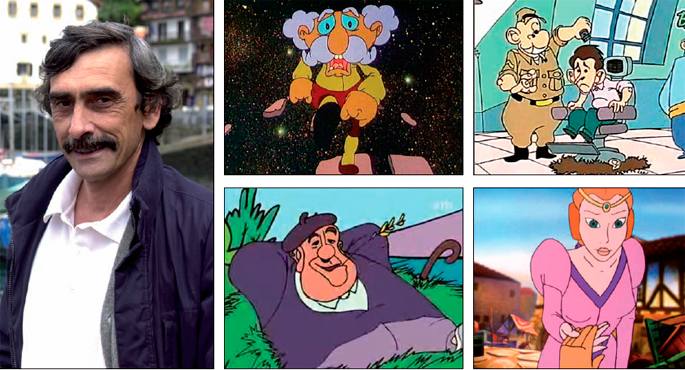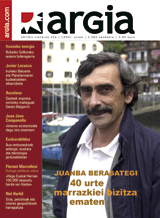Well-deserved award to the father of Kukubiltxo and Galtzagorri
- Juanba Berasategi (Pasai Donibane, 1951) is one of the pioneers of animation in the Basque Country. Taking advantage of the Zinemira Award of the San Sebastian Film Festival, we have reviewed the trajectory of the CARTOONIST and the director.

“I was an artist and I wanted to be an artist, and every artist did it. He spent a season in Paris, drawing naked models to the boredom at Beaux Arts Elementary School and revolutionizing Vincennes university dining rooms. He came to see us with a French evil and server of Vasarely's theories. We started plundering scrap chunks on the Pasaia pier to make the sculptures. Cinema, then, was just interested in making avant-garde. He had a super-8, and he had taught us long before Sistiaga what could be achieved by directly mistreating the celluloid. He went from experimentation to Czech drawings, and one day he presented us with a wooden table full of leaflets and millimeter rules. Our first cartoon atelier was already underway.” This was described by the writer Koldo Izagirre (Argian, 1999), as one of the beginnings of Berasategi.
From his work at the Atelier, the first animated short film in Basque directed by Berasategi was born: East Star (1977). At that time there was no school, but the pasaitarra learned “reading books and watching movies”, “to fit on the projector and on paper, to analyze the solutions that each movement needed”. Berasategi is also the author of the first animated feature in Basque: Pumpkin (1985). “Here, in the Basque Country, that is not possible, how are you going to do it? That's in France, in America -- but here? They told him from the institutions, but after five years of work, thanks to the help of some thirty people who had no more pay than the cost of the bus ticket and the daily snack, a film was released that included legends such as Xaxpiki, the blacksmith Patxi or Kukubiltxo, at the San Sebastian Film Festival. He was awarded a mention of honour at the festival and was appointed of special quality by the Spanish Ministry of Culture. According to the director, the film had two clear objectives and both were accomplished: Talk about Basque Country and Basque. “I’ve never brainwashed to decide if I had to make films in Basque. I just felt it. The film is the image and sound, and I transmit it with the Basque as comfortably as possible.” Koldo Izagirre’s hand has also been noted in the script work of the film.
“Below all the butchers, above all the clouds,” the good man condemned to be the satellite of Calabaza, since he mixed the expression to his return from Akelarre, begins a film that has enjoyed many generations. I asked Berasategi how he remembered it in his book The Looks of Celluloid: “When I see it now I find it an old, limited, small film that needed an effort from all over the world. The tools at the time were very deficient and some characters have clumsy movements. It seems to me that it has been dark, like the manumatized, but at the same time I see elements that seem impossible for that time, the multi-layered. Imagine that today they are not being made, that with that artifact these photograms are obtained based on frames for travelling… Right now I would not be able to make those drawings. There are frames to roll for a week and imagine you’ve been wrong on the 3.521… Get back started! In addition, it had to be an hour-and-a-half movie, just like the others, to the height of the others. Today many films have about 70 minutes, because children do not support them, but we had to do as the Americans… It was a titanic job, which will not happen again in life. From an aesthetic point of view there are also nice things: Tartalo, Galtzagorri -- he has something. At that time, the placement of Galtzagorri in Eibar was not just a matter, along with Bilbao was the biggest urban disaster in Euskal Herria, the train passed through the street centre! There we put Galtzagorri in between the factories. When I watch the film, I say, one day I have to do the Triptic Pumpkin 2, removing that aspect of old and improving it with current techniques, but without too many changes, keeping the characters, bringing mythology to the current situation, with a little more katxondeo, no complexes”.
In collaboration with Andalusia, Berasategi performed Ahmed, prince of Alhambra (1997). Based on the stories of the Alhambra in Washington Irving, it is the work of the most commercialized Passover writer and, after his welcome, the second part came: Alhambra Key (2003).
More successful than football
“And you’re going to get bigger in the future, in your smallness.” Thus began the successful series of 52 episodes led by the director, who came to gather more spectators than football: Lazkao Txiki 1998-1999. Despite the simple images, the content attracted people: through the anecdotes of bertsolari, Lazkao Txiki is a reflection of the historical, social and political reality in a rural and traditional Basque environment. In chapter 13, Fernando Amezketarra was produced by Aitzina (1994-1995) and subsequently dedicated himself to directing the life of another bertsolari: Txirrita of Article 52 (1999-2000) Biography of a life full of anecdotes narrated with acute humor.
Juanba Berasategi has been involved in some of the fictions and documentaries for adults, and because of the circumstances, he has also been involved as an entrepreneur in the world of film. But above all, his name is linked to animation, cartoonist, director. His latest film work is Barriola, San Adriango Azeria (2008), set in the Aizkorri carboneros. On television, the premiere of Tormesko, the blind ditch, is pending. If everything goes well, it will be issued before Christmas, in ETB1 and eitb.eus. “In cinemas there is more and more competition and more vertigo when entering these types of projects, it’s a lot of money. If you risk it, you have to do it by telling more beautiful stories.” He will tell nice stories to tell, as he has in mind three or four projects for film.
He will continue to work without giving up his style, knowing that the current animation has changed a lot with respect to the early times: “You’re told that a child doesn’t support a plan today that lasts for more than three seconds, and you think it’s a lie, but then you realize that children consume a lot of advertising, advertisements at a high rate, that they have a lot of changes in light and plane, and that young people are also used to plans that mix violence and speed. I don't like the current imperatives, because they're habits of television and advertising, but in the end, people learn that rhythm, introduce that way of consuming stories, and they're able to follow three movies at a time by changing the television channels. We have that culture.”
In the age of three dimensions, anime and manga, technology does not dazzle. “A lot of people love the ability of the computer, but the key is not what the computer knows how to do, but what you know how to do. There's a lot you know how to handle the machine and a few technicians. All they do is shape and move the character technologically, and no, what you have on the screen is an actor, it has to move in a certain way, it has to look, it has to do with personality, gestures and ways of speaking. All of that is noted in the movie, let's see if you've taken care of it. We keep writing the characters' keys, and then we try to get all that through the computer. First you have to take the paper and draw, draw, draw… to learn and then use the computer.”
Sweet potato prize
28 years after presenting the triptych Kalabaza, Juanba Berasategi will receive the award at the San Sebastian Film Festival. “I’m not a reward – I confess – I’m ashamed, but it comes from my friends and it’s a joy that people in the sector remember me and recognize my trajectory. At the same time, the prize comes at the toughest time, because the economic crisis is shaking and there is a risk of losing the creative and technical experience that we have been accumulating over the years. Without economic pressure there is no production and if the professionals here go outside, we will lose it, it is my concern to go back to the times of the Squash Ventruda”.
However, we want to finish the report with a touch of hope, highlighting these words from the CARTOONIST: “In Euskal Herria we make worthy products with a small budget and a great effort. And that dignity is achieved by a group of people, enthusiasm, illusion; that is a value in the Basque Country, because it is a work with a lot of vocation”. This has been demonstrated by the trajectory of many years in the case of Juanba Berasategi. Congratulations.
Donostiako Zinemaldiko kartel lehiaketa abian da gaurtik. Aukera paregabea iazko Sail Ofizialeko kartelaren plagioa gogora ekartzeko.
Nahiko itxurosoa zirudien palmaresa Club Sándwichek eta Pelo malok irabazi dituzten bi sari handienekin hondatu dute.
Kritika eta publikoa bat etortzen direnean, pelikula batek ikusleen txaloak eta kritikarien laudorioak jasotzen dituenean, aintzat hartu beharreko obraren aurrean gauden seinale. Horren adibide dugu Hirokazu Kore-eda zuzendari japoniarraren Soshite chichi ni naru/Like father,... [+]
Banatu dira 61. Donostiako Zinemaldiko sariak. Pelo malo film venezuelarrak irabazi du film onenaren Urrezko Maskorra.
Jean-Pierre Jeunetek Amelieren ildotik doan beste film bat egin du, pertsonaia miragarri eta sinesgaitz samarra protagonista duena.
Bosniako gerraren arrastoek turista australiar batengan duten eragina erakusten du Jasmina Zbanicen For those who can tell no tales filmak.
Pertsonaia-ikerketa da Fernando Francoren La herida filma. Faktura aseptikodun lana, Marian Alvarezen interpretazio sendoan oinarritzen da.
Generoak nahastea ez da erraza eta beti ez da ongi ateratzen, baina filma gai denean thriller trebe bat drama garratz batekin naturaltasunez uztartzeko, gai denean koktelera berean eskaintzeko suspentsea, tentsioa eta korapilatzen den trama batetik, sufrimendua, giza... [+]
Gaztea eta ederra da Jeune et jolie filmeko protagonista. Ez du premia ekonomikorik, ez familia arazorik, ez txikitako traumarik. Orduan, zergatik? Zergatik erabaki du 17 urterekin prostituitzea? Beharbada horrexegatik, bizimodu burgesak sortzen dion asperduragatik,... [+]
Ia genero bihurtzeraino hedatu den epaiketa-film (trial film edo courtroom drama ingelesez) horietako bat da Atom Egoyanek Sail Ofizialean aurkeztu duen Devil’s Knot.
Burua galtzen hasi dela-eta ama ospitalera eraman dutenean desegin da Nereak daraman bizimoduaren oreka hauskorra: bikote harremana, alaba, lana eta orain ama zaindu beharra gehiegi da pertsona bakarrarentzat. Hala abiatzen da Amaren eskuak filma. Beteta zegoen edalontziak... [+]
Pilotu automatikoarekin zuzendutako film horietako bat da The railway man, gerrak eta torturak eragindako traumak ardatz dituena, baita horiengatik mendekua hartzeko gogoa ere.
Ama-semeen arteko zilbor-hestea apurtzea da Club Sándwich filmeko gaia eta estilo minimalistan kontatua dago.
Eta biolentzia gehiago. Biolentziak inguratzen gaitu, biolentoak gara. Hala berresten dute albistegiek, eguneroko gertakariek. Zinemak, baita aurtengo Zinemaldiak ere, zeharka edo zuzenean pelikula ugaritan jorratu du gaia. Dagoeneko saturatuta gaude, anestesiatuta,... [+]

























